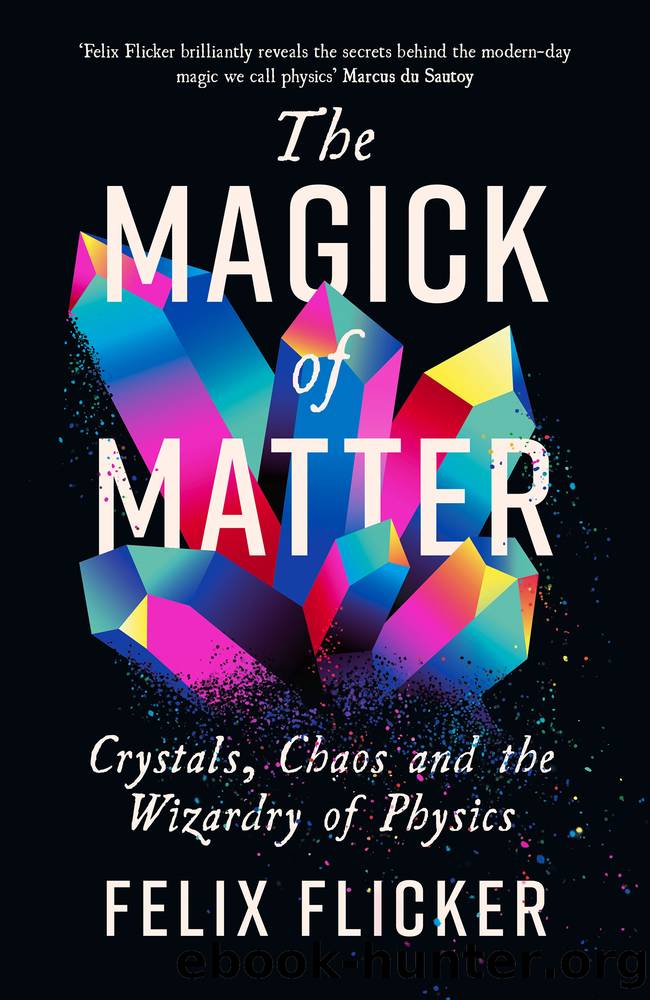The Magick of Matter: Crystals, Chaos and the Wizardry of Physics by Felix Flicker

Author:Felix Flicker [Flicker, Felix]
Language: eng
Format: epub
Publisher: Profile Books
Published: 2022-01-15T00:00:00+00:00
You can measure quantum tunnelling yourself without expensive apparatus. One of the best places to see it is your familiar local tavern, provided theyâll have you back at this point. Press a slightly damp finger to the outside of your full beer glass. View your fingerprint through the beer: youâll see that itâs very clearly outlined, with the ridges dark and the troughs light. Why is this? Well, the light you see is reflecting off the inside of the glass. But the ridges of your fingerprints get so close to the outside of the glass that the photons inside the glass are able to tunnel into your skin. They are therefore not reflected, and appear as dark lines. But the effect is very sensitive, and the troughs of your fingerprints are already too far from the glass for any appreciable tunnelling; hence the light is reflected from these parts.
What actually happens when a particle tunnels? It started on one side of a barrier, was found on the other, and never had enough energy to exist in the region in between. The name given to these types of mysterious processes is âquantum fluctuationsâ. The name is misleading because it suggests the particle is gaining and losing energy constantly and randomly, which isnât true: energy is conserved in quantum mechanics just as it is classically. What is happening here is more magical than that.
Tunnelling is one of the clearest examples of the quantum realmâs basis in probabilities. To be clear, the phenomenon can also occur in classical waves: there is a classical description of the beer-glass effect, which is that the light takes the form of an âevanescent waveâ connecting the glass and your finger. The quantum mystery comes in only when individual particles are able to tunnel (photons in this case), which has no classical analogue: quantum means discrete. So far the discussion has concerned such individual particles; but one of the most remarkable developments in quantum mechanics since Einsteinâs work was the realisation that not only can it account for many particles at once, but it must do so if it is to remain consistent with one of his other great breakthroughs of 1905, special relativity. The merger of these two ideas is called quantum field theory, and it is the basis of modern physics.
Download
This site does not store any files on its server. We only index and link to content provided by other sites. Please contact the content providers to delete copyright contents if any and email us, we'll remove relevant links or contents immediately.
The Complete Stick Figure Physics Tutorials by Allen Sarah(7307)
Secrets of Antigravity Propulsion: Tesla, UFOs, and Classified Aerospace Technology by Ph.D. Paul A. Laviolette(5309)
Thing Explainer by Randall Munroe(3877)
The River of Consciousness by Oliver Sacks(3538)
The Order of Time by Carlo Rovelli(3145)
How To by Randall Munroe(3033)
A Brief History of Time by Stephen Hawking(2960)
I Live in the Future & Here's How It Works by Nick Bilton(2935)
The Great Unknown by Marcus du Sautoy(2646)
What If?: Serious Scientific Answers to Absurd Hypothetical Questions by Randall Munroe(2637)
Midnight in Chernobyl by Adam Higginbotham(2483)
Blockchain: Ultimate Step By Step Guide To Understanding Blockchain Technology, Bitcoin Creation, and the future of Money (Novice to Expert) by Keizer Söze(2445)
Networks: An Introduction by Newman Mark(2360)
The Meaning of it All by Richard Feynman(2300)
Easy Electronics by Charles Platt(2281)
The Tao of Physics by Fritjof Capra(2229)
Midnight in Chernobyl: The Untold Story of the World's Greatest Nuclear Disaster by Adam Higginbotham(2177)
When by Daniel H Pink(2082)
Introducing Relativity by Bruce Bassett(2076)
